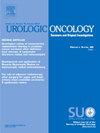比较机器人辅助肾部分切除术和图像引导经皮冷冻消融术治疗cT1肾细胞癌的倾向得分匹配分析。
IF 2.3
3区 医学
Q3 ONCOLOGY
Urologic Oncology-seminars and Original Investigations
Pub Date : 2024-10-05
DOI:10.1016/j.urolonc.2024.09.012
引用次数: 0
摘要
研究目的本研究旨在比较机器人辅助肾部分切除术(RAPN)和图像引导经皮冷冻消融术(IG-PCA)治疗临床T1肾细胞癌的临床疗效:我们对2012年至2021年间接受RAPN或IG-PCA治疗的679例临床T1肾细胞癌患者进行了回顾性分析。通过逻辑分析计算倾向得分,以调整基线特征的不平衡。我们比较了两个治疗组的肿瘤和功能结果:结果:经过配对,每组各有 108 名患者。RAPN组没有患者出现局部复发。在IG-PCA组中,有3名患者出现局部肿瘤进展。这些患者通过二次技术接受了挽救性热消融治疗,其中 2 人接受了 IG-PCA 治疗,1 人接受了微波消融治疗,结果局部控制率达到 100%。Kaplan-Meier 分析显示,两组患者的 5 年无复发生存率、无转移生存率和总生存率差异无统计学意义(对数秩检验;分别为 P = 0.11、P = 0.64 和 P = 0.17)。在主要并发症和总并发症发生率方面,两种治疗方法无明显差异(P = 0.75 和 P = 0.82)。两组患者在治疗后12个月估计肾小球滤过率下降小于10%的比率和5年肾功能保留率相似(分别为P = 0.88和P = 0.38):IG-PCA的肿瘤治疗效果与RAPN相当。结论:IG-PCA 的肿瘤治疗效果与 RAPN 相当。RAPN 解决了传统手术的缺点,其安全性与 IG-PCA 相当。本文章由计算机程序翻译,如有差异,请以英文原文为准。
Propensity score-matched analysis comparing robot-assisted partial nephrectomy and image-guided percutaneous cryoablation for cT1 renal cell carcinoma
Objectives
This study aimed to compare the clinical outcomes of robot-assisted partial nephrectomy (RAPN) and image-guided percutaneous cryoablation (IG-PCA) for clinical T1 renal cell carcinoma.
Materials and Methods
We conducted a retrospective analysis of 679 patients with clinical T1 renal cell carcinoma treated with RAPN or IG-PCA between 2012 and 2021. Propensity scores were calculated via logistic analysis to adjust for imbalances in baseline characteristics. We compared oncological and functional outcomes between the 2 treatment groups.
Results
Following the matching process, 108 patients were included in each group. No patient in the RAPN group developed local recurrence. In the IG-PCA group, three patients experienced local tumor progression. The patients underwent salvage thermal ablations by the secondary technique; 2 underwent IG-PCA and 1 underwent microwave ablation, resulting in a local control rate of 100%. The Kaplan–Meier analysis showed no statistically significant differences between the groups in terms of 5-year recurrence-free survival, metastasis-free survival, and overall survival (log-rank test; P = 0.11, P = 0.64, and P = 0.17, respectively). No significant differences were observed in the 2 treatments in major and overall complication rates (P = 0.75 and P = 0.82, respectively). Both groups showed similar rates of less than 10% estimated glomerular filtration rate decline at 12 months post-treatment and 5-year renal function preservation rates (P = 0.88 and P = 0.38, respectively).
Conclusions
IG-PCA demonstrated oncological outcomes comparable to those of RAPN. RAPN addressed the disadvantages of conventional procedures and allowed for safety outcomes comparable to IG-PCA.
求助全文
通过发布文献求助,成功后即可免费获取论文全文。
去求助
来源期刊
CiteScore
4.80
自引率
3.70%
发文量
297
审稿时长
7.6 weeks
期刊介绍:
Urologic Oncology: Seminars and Original Investigations is the official journal of the Society of Urologic Oncology. The journal publishes practical, timely, and relevant clinical and basic science research articles which address any aspect of urologic oncology. Each issue comprises original research, news and topics, survey articles providing short commentaries on other important articles in the urologic oncology literature, and reviews including an in-depth Seminar examining a specific clinical dilemma. The journal periodically publishes supplement issues devoted to areas of current interest to the urologic oncology community. Articles published are of interest to researchers and the clinicians involved in the practice of urologic oncology including urologists, oncologists, and radiologists.

 求助内容:
求助内容: 应助结果提醒方式:
应助结果提醒方式:


